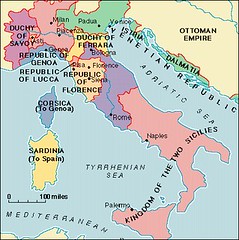Italy did not exist as a political entity in the early modern period, reminds Wikipedia.
Instead, it was divided into smaller city states and territories: the Kingdom of Naples controlled the south, the Republic of Florence and the Papal States at the center, the Genoese and the Milanese to the north and west respectively, and the Venetians to the east.
Fifteenth-century Italy was one of the most urbanised areas in Europe.[32] Many of its cities stood among the ruins of ancient Roman buildings; it seems likely that the classical nature of the Renaissance was linked to its origin in the Roman Empire's heartland.[33]
It has long been a matter of debate why the Renaissance began in Florence, and not elsewhere in Italy. Scholars have noted several features unique to Florentine cultural life which may have caused such a cultural movement. Many have emphasized the role played by the Medici, a banking family and later ducal housefamily, in patronizing and stimulating the arts.
Lorenzo de' Medici (1449–1492) was the catalyst for an enormous amount of arts patronage, encouraging his countryman to commission works from Florence's leading artists, including Leonardo da Vinci, Sandro Botticelli, and Michelangelo Buonarroti.[5]
Some historians have postulated that Florence was the birthplace of the Renaissance as a result of luck, i.e. because "Great Men" were born there by chance.[41] Da Vinci, Botticelli and Michelangelo were all born in Tuscany. Arguing that such chance seems improbable, other historians have contended that these "Great Men" were only able to rise to prominence because of the prevailing cultural conditions at the time.
Tuesday, March 9, 2010
Subscribe to:
Post Comments (Atom)





No comments:
Post a Comment